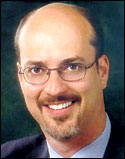
Despite the slew of news stories coming out of the Digital Cinema Summit at the NAB Show this past weekend there was little new to report regarding technological advances and nascent business deals. In fact, the if the only real news that seemed to come out of the summit was the frustration over the fact that there was little new to talk about.
Because the summit is held a month after ShoWest the expectation going in was that nothing major would be announced by major players in the space such as studios, integrators or vendors, though some industry players used the forum to voice their opinions, controversial or not, about the lack of speed with which d-cinema is being adopted. Attendees were dealt a one-two punch during the Sunday sessions by speakers Michael Karagosian of MKPE and John Fithian, the President and CEO, National Association of Theatre Owners.
Moderating a morning panel discussion titled “The Exhibition Perspective: Truth and Consequences in the D-Cinema Rollout” Karagosian highlighted the issues acting as roadblocks to d-cinema adoption, including the dwindling virtual print fees (VPFs)studios are willing to pay. Some studios, such as Warner Bros. have been slow to sign up to VPF agreements, or haven’t signed them at all. According to The Hollywood Reporter Karagoisan suggested:
. . . .that if one major studio held back annually on just two blockbuster titles that the exhibitor contributions might grow from 20% to 32% of the total.
This could be a real problem since, as Karagosian pointed out, the cost for an exhibitor to make the conversion to digital could be as high as 200% – 300% more than sticking with current film based systems over the next 25-years.
 After lunch, John Fithian gave a dutch uncle keynote address which had everyone buzzing, since he played no punches in pointing out the pending “train wreck” the industry could be headed for if the number of d-cinema installations don’t increase before 2009 when studios plan on releasing 10 films in digital 3-D, including James Cameron’s “Avatar”. Variety reports that Fithian stated of the upcoming releases:
After lunch, John Fithian gave a dutch uncle keynote address which had everyone buzzing, since he played no punches in pointing out the pending “train wreck” the industry could be headed for if the number of d-cinema installations don’t increase before 2009 when studios plan on releasing 10 films in digital 3-D, including James Cameron’s “Avatar”. Variety reports that Fithian stated of the upcoming releases:
“We don’t have the screens for them. We have less than 1,000 3-D screens in the U.S. and fewer than that in the rest of the world.”
Fithian then turned his attention to the stalemate occurring between studios and exhibitors over VPFs which are meant to subsidize the rollout of D-cinema equipment.
“Unless the deals are done in the next month or two we won’t have time to do the installations in time. We literally need the deals now to make the slate work. If the studios want this to happen in time for 2009, the deals have to be struck, and they have to be struck right now.”
Whether VPF agreements start closing or not some exhibitors may still take a wait and see approach. Mark Collins of Marcus Theatres, who participated in Karagosian’s panel discussion, said of his circuit’s conversion to digital:
“We have not seen any cost benefits. We need to start promoting digital cinema as something that is different from what (moviegoers) have.”
Though many in the industry have made similar statements, Collins may be onto something as this type of marketing approach has worked in the past during the rollout of digital audio in movie theatres.
The summit also played host to the usual suspects from studios, such as Howard Lukk, Disney’s Vice President of Production Technology and Wendy Aylsworth, the Sr. Vice President of Technology at Warner Bros. Both spoke mostly of technical issues such as the need for more 3-D production and post-production equipment. Aylsworth focused on the problem of subtitles in 3-D content, a topic she previously presented with a great depth of knowledge at the SMPTE conference in October of 2007.
- Edinburgh Filmhouse Secures 25-Year Lease, Announces New Patrons - July 11, 2024
- Mixed Results for Global Box Office During First Half of 2024 - July 10, 2024
- George Rouman, Cinema Operator and Industry Champion, Dies at 51 - June 13, 2024